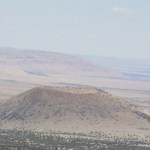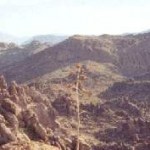Arizona
My current model (subject to change) puts Arizona in the Clinton Column. This is the prediction that has resulted in the most head scratching from those observing this, but it turns out that the Clinton Campaign seems to agree. Clinton surrogates, including Chelsea, Michele Obama, and Bernie Sanders will be in the state over the next few days.
Frankly, I worry about good people going to Arizona stumping for a Liberal Democrat. Perhaps that is because of my own experience living there for several weeks. During that time a local desperado was arrested and made a court appearance, and his…
The Arizona Physiological Society held their 8th annual conference Nov 13-14 at Midwestern University in Glendale. This was a great meeting for comparative physiologists!
Here are some comparative physiology highlights from the meeting:
The 2015 Keynote Speaker was Dr. Andrew Biewener (Harvard University) who spoke about "How do running animals acheive stability? The neuromechanical control of rapid locomotion." In his talk he focused on understanding how Guinea fowl avoid tripping when running really fast over uneven surfaces.
The 2015 Arizona Distinguished Lecture was given by Dr.…
This is an exciting weekend for science!
This Friday and Saturday the 8th annual Arizona Physiological Society is hosting their annual conference in Glendale, Arizona. The keynote speaker will be Dr. Andrew Biewener (Harvard University) who will present “How Do Running Animals Achieve Stability? The Neuromechanical Control of Rapid Locomotion.” The Arizona Distinguished Lecturer will be Dr. Eldon Braun (University of Arizona) who will present “The Comparative Physiology of Osmoregulation: Lessons from Avian Studies.”
The second meeting of TetZooCon, otherwise known as the Tetrapod…
One of the biggest medical conspiracy theories for a long time has been that there exist out there all sorts of fantastic cures for cancer and other deadly diseases but you can’t have them because (1) “they” don’t want you to know about them (as I like to call it, the Kevin Trudeau approach) and/or (2) the evil jackbooted thugs of the FDA are so close-minded and blinded by science that they crush any attempt to market such drugs and, under the most charitable assessment under this myth, dramatically slow down the approval of such cures. The first version usually involves “natural” cures or…
There are times when supporting science-based health policy and opposing health policies that sound compassionate but are not are easily portrayed as though I’m opposing mom, apple pie, and the American flag. One such type of misguided policy that I’ve opposed is a category of bills that have been finding their way into state legislatures lately known as “right to try” bills. Jann Bellamy over at SBM and I have both written about them before. With the passage of the first such bill into law in Colorado in May, followed by Missouri and Louisiana, and its heading to the voters of Arizona as…
The Colorado River, recently named America’s most endangered river, supports millions of people in the American Southwest and northwest Mexico and helps irrigate millions of acres of land. It is shared by seven states in the U.S. and Mexico, through a complex series of legal agreements and treaties.
Yet every drop of water on the river is accounted for, used, reused, and transpired away, and today, no water reaches the Colorado River delta in an average year. Quite simply, demands on the river exceed the river’s average supply, and this problem is projected to get worse as populations…
"Don't go around saying the world owes you a living. The world owes you nothing. It was here first." -Mark Twain
So, you've been around a while, seen all sorts of things, and learned an awful lot about the world, solar system and Universe that we live in. But how well do you know it, really?
Image credit: NASA / Lunar and Planetary Laboratory.
To scale and in order, these are the eight planets you know so well. There are the four rocky worlds of our inner solar system: Mercury, Venus, Earth, and Mars, and the four gas giants that dominate the outer solar system: Jupiter, Saturn, Uranus, and…
Maryn McKenna has an excellent post on 2008's measles outbreak in Arizona. 14 confirmed patients, 8,321 individuals tracked down, 15,120 work hours lost at 7 Arizona hospitals due to furloughs of staff who were not appropriately vaccinated, and almost $800,000 spent by 2 hospitals just to contain the disease--and it all could have been prevented.
The author, dishing.
To get to the National Radio Telescope Observatory, you have to be committed.
Well, first, you have to be in New Mexico -- about an hour's drive south of Albuquerque, in the plains of San Augustin, to be precise, a Pleistocene lakebed bordered by the northern end of the Chihuahuan Desert and dotted with arid shrubs. Despite being some 6,970 feet above sea level, it feels like the basement of the world, wide and flat and under the massive Southwestern sky. Driving to the Observatory, the home of the famous "Very Large Array" of radio telescopes, is an exercise in…
Well, this MVP was a bit trickier than most, thanks to the fact that most scoria/cinder cones look pretty similar and some initial confusion about the photo in the first place. Anyway, lets review!
The photo:
It was identified by the sender as Missouri Bill Hill in Arizona. However, this doesn't seem to be the case.
From Google Earth, Missouri Bill Hill:
After close examination by me and all of you, it seems that the consensus is that it is, in fact, Antelope Hill in Arizona - both near each other in the same volcanic field.
From Google Earth, Antelope Hill:
This leaves me confident that…
tags: Black-chinned Hummingbird, Archilochus alexandri, birds, nature, Image of the Day
Male black-chinned Hummingbird, Archilochus alexandri, Cave Creek Canyon, AZ.
Image: Dave Rintoul, June 2008 [larger view].
tags: Yellow-eyed Junco, Junco phaeonotus, birds, nature, Image of the Day
My good friend, Dave Rintoul, has just returned from a much-deserved vacation camping in the Chiricahuas and Gila Wilderness area and sent a couple images to share with you.
Yellow-eyed Junco, Junco phaeonotus, Cave Creek Canyon AZ
Image: Dave Rintoul, June 2008 [larger view].
tags: Acorn Woodpecker, Melanerpes formicivorus, birds, nature, Image of the Day
My good friend, Dave Rintoul, has just returned from a much-deserved vacation camping in the Chiricahuas and Gila Wilderness area and sent a couple images to share with you.
Acorn Woodpecker, Melanerpes formicivorus, on the trunk of an Alligator Juniper, Cave Creek Canyon AZ.
Image: Dave Rintoul, June 2008.
tags: Blue-throated hummingbird, Lampornis clemenciae, birds, nature, Image of the Day
My good friend, Dave Rintoul, has just returned from a much-deserved vacation camping in the Chiricahuas and Gila Wilderness area and sent a couple images to share with you.
Juvenile male Blue-throated Hummingbird, Lampornis clemenciae, Cave Creek Canyon, AZ.
Image: Dave Rintoul, June 2008 [larger view].
For comparison, an adult male of the species -- also read the comments section to learn more about how to identify juvenile males of this species.
Centruroides sculpturatus - Arizona Bark Scorpion
I have a hard time getting worked up over stuff that happened 25 years ago. But here's something that still angers me every time I think of it.
One of those educational safety movies we were shown back in grade school- you know, the "Stop-Drop-and-Roll" variety- presented the dangers of the Bark Scorpion. The film featured dark tones and a dramatic reenactment of a deadly encounter, complete with screams and fainting.
This was shown in Rochester, New York, mind you. We don't have scorpions anywhere near Rochester. The climate is is far…
Zooillogix welcomes you back to our favorite ill-conceived, questionably licensed, death-circus: Tiger Splash Park! Any Arizona state legislators amongst our readers? If so, you might want to put this place to sleep...
Thanks to dedicated reader Judy for making this vid and sending us the link.
Those of you who know me know that I'm unhappy living here in Arizona. The landscape and ecosystem of the Sonoran Desert, while beautiful to many, is too dry, rocky, and devoid of life for me to enjoy living here.
After my time here, I've decided that, were it somehow offered to me, I would probably pass on the opportunity to go to Mars. And so I present to you a little game I call "Mars or Arizona," where I will show you some pictures, and you get to guess which ones are pictures of Mars and which ones are pictures of Arizona. Sound easy?
Well let's bring on the pictures, and see if you…
The Saguaro might, one could fancy, be a tree designed by someone who had never seen a tree.
-Donald Culross Peattie, 1950
Colliuris sp. long-necked ground beetle, Arizona
details: Canon MP-E 65mm 1-5x macro lens on a Canon 20D
beetle on plain white paper
f/13, 1/250 sec, ISO 100
MT-24EX twin flash diffused through tracing paper
levels adjusted in Photoshop
If I had to pick a favorite myrmicine ant, I'd go with the heavily armored Neotropical genus Cephalotes. These arboreal ants are typically thought of as rainforest canopy dwellers, but we have a desert species here in Arizona, Cephalotes rohweri, that is the northernmost species in an otherwise tropical genus. They nest in abandoned beetle burrows in the dead wood of living Palo Verde trees.
Earlier this month, myrmecologist Scott Powell was in town to scope out a potential research project on our local populations. Scott has been studying how the nesting ecology of…





